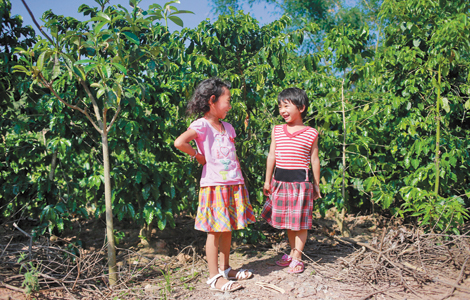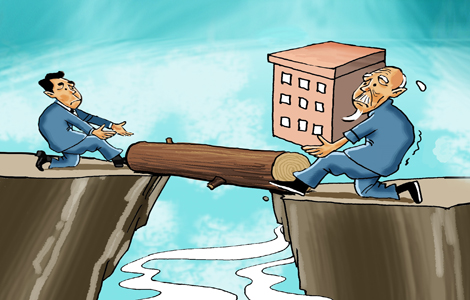The task of better feeding China
Updated: 2013-06-22 08:24
By Zhu Jin (China Daily)
|
|||||||||||
Management of land and water resources must be strengthened to ensure healthy growth of food production to meet demand
How to better feed its huge population remains a constant concern for China. The country's food security has improved significantly and the number of undernourished people has declined considerably over the past three decades. But increasing consumption and growing resource constraints, as a result of China's rapid economic growth, have made better feeding China a daunting task.
The fact that it has comparatively little arable land and freshwater sources has made self-sufficiency in food, especially in the two staples of rice and wheat, the top priority for China. Its achievements in this regard, though, have been remarkable since the late 1970s when agricultural and rural reforms were introduced.
"Since 1978, its volume of agricultural production has grown almost five-fold and the country has made significant progress toward food security with the number of undernourished falling by almost 100 million since 1990," Jose Graziano da Silva, director-general of the UN Food and Agriculture Organization, said at the opening ceremony of the 2013 World Agricultural Outlook Conference in Beijing on June 6.
But it will be a long-term challenge for China to maintain this momentum. Last year, the World Trade Organization said China had replaced the United States as the world's largest importer of agricultural products. Although China is self-sufficient in basic food grains, it has become so by importing other agricultural products which compete for land and water. For example, China's dependence on foreign soybean is close to 80 percent now, and the import of oilseeds and dairy products is likely to remain high in the coming years.
According to the 2013-22 World Agricultural Outlook, published by the Organization for Economic Cooperation and Development and the FAO in June, the consumption of the main agricultural products over the next decade in China is expected to outpace the growth in agricultural production by about 0.3 percent a year, driven by growing population, higher incomes, urbanization and changing diets.
Better feeding a population of 1.3 billion people, in particular reducing the number of undernourished people, estimated to be about 158 million, remains the government's top priority and the basic goal of its agricultural policy. The country has to make greater efforts to manage land and water resources, mitigate the effects of climate change on agriculture and safeguard biodiversity.
Smallholder farming is a basic feature of China's agriculture. In the 1980s, the household contract responsibility system replaced the commune system, enabling individual farmers to lease land from the collectives and become largely autonomous in their decision making. This boosted agricultural output, sometimes at the cost of the environment and sustainability.
Farmers, however, cannot accord priority to the environment and sustainability until their incomes - far less than that in urban areas - reach a respectable level. And the onus of increasing their incomes lies with the government. Also, local authorities should provide farmers with more information to help them adopt climate-smart agricultural practices and become more innovative.
"Only when farmers attach importance to sustainable agricultural development and its values become incorporated into conscious behavioral norms will it be possible to make agricultural development sustainable in China," said Ni Hongxing, director-general of the Agricultural Trade Promotion Center, affiliated to the Ministry of Agriculture, in a recent report.
Related Stories
Major source for Beijing water plan 'polluted' 2013-06-22 08:22
Pollution crimes to be severely punished 2013-06-19 21:53
'Legal weapons' against pollution offenses 2013-06-19 07:47
Less carbon, less pollution 2013-06-18 07:47
China shows resolve, action against air pollution 2013-06-15 17:14
10 steps taken to curb air pollution 2013-06-15 07:47
Today's Top News
France wants more Chinese investment
FM: China rejects US' claim on Snowden
Public interests Party's top priority
Overseas sellers upbeat on China
PBOC will act 'if necessary'
4 Chinese killed in Papua New Guinea
'Heavy losses' if China-EU solar sector talks fail
Riots in Xinjiang kill 27
Hot Topics
Lunar probe , China growth forecasts, Emission rules get tougher, China seen through 'colored lens', International board,
Editor's Picks

|

|

|

|

|

|





